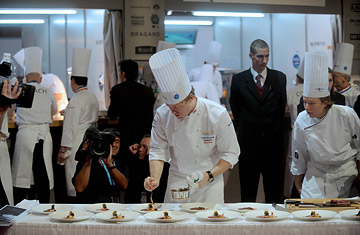
U.S. chef Timothy Hollingsworth prepares to show a dish during the Bocuse d'Or, an international cooking contest named for one of France's legendary chefs
Perhaps nothing symbolized the U.S. team's efforts at the Bocuse d'Or better than its beef cheeks. At the world's premier chef's competition, which ended on Jan. 28 in Lyon, France, the Estonians transformed the cheeks — a required ingredient in this year's contest — into pot-au-feu; the Brazilians stuffed potatoes with them; and the Malaysians spiced them up into rendang. But the U.S. competitors, Timothy Hollingsworth and his assistant, Adina Guest, braised the meat until it was silky, set it on a tiny round of baby turnip, and topped it with a floret of broccolini. Smuggled through customs, the vegetables came straight from the garden of the famed French Laundry restaurant in Napa, Calif., where the two chefs work. It gave the presentation a delicious, locally grown flavor that could only be American. Sadly, in a context where extravagance and adherence to the rules of classical cooking take precedent, that might have been part of the problem. The U.S. team placed sixth. The Norwegians won gold, Sweden took silver and France bronze. (See pictures of Bocuse d'Or 2009.)
The Scandinavians triumphed because they immersed themselves in the French essence of the contest. From the heavy presence of seafood mousses to the cheesy, Maurice Chevalier compliments the emcee paid the female judges, the Bocuse d'Or is nothing if not French. But because it is also a kind of culinary Olympics, with teams from 24 countries competing over two days for a gold trophy that brings unmatched prestige and a 20,000-euro prize, the contest is imbued with nationalist rivalries that extend from the fans in the bleachers to the flavors on the elaborate platters. In fact, for the young chefs who compete in the contest, founded 22 years ago by Paul Bocuse, one of France's most revered chefs, navigating the tension between the desire to demonstrate the glories of their national cuisine — to say nothing of their own creativity — and a jury that tends to favor strongly the classic French style is precisely the challenge. (See pictures from the 2008 Olympic Games in Beijing.)
For the fans, the Bocuse might as well be the World Cup, so passionate (and loud) are their loyalties. Wearing T shirts with the red field and white cross of their national flag, the Swiss team rang cowbells and cheered with an intensity matched only by the home-team fans, who alternated between long, deafening horn blasts and belting out "Le Marseillaise." The British, a decidedly smaller delegation, hung T shirts printed with the encouragement "Allez les rosbifs" over the rails. Even South Korea — its fans dressed in chefs' whites, their faces painted with the national flag — managed to send out the occasional deafening cheer. (See pictures of food served in its natural setting.)
With nearly 50 people, the U.S. fielded its largest delegation ever. "Last time, our uniform was a sweatshirt that my wife ironed U.S.A. decals onto," says Gavin Kaysen, who competed for the U.S. in the 2007 Bocuse. Now dressed in one of the sleek, matching jackets and T shirts printed with the words "Je t'aime USA" worn by team members and their supporters, Kaysen, who is advising Hollingsworth and Guest, added, "It's totally different this time. We have so much more support."
That newfound support stems in large part from the key figures leading the team. President Thomas Keller, chef of the French Laundry, signed on when he was approached by none other than Bocuse himself. "When Monsieur Bocuse asks you, you say, 'Yes, chef,' " Keller explains. He transformed his father's old house, located next door to the Napa Valley restaurant, into a training center for Hollingsworth and Guest. Together, Keller and honorary Bocuse president and New York City four-star chef Daniel Boulud were determined, as Boulud says, "to show what amazing food we cook in the U.S."
